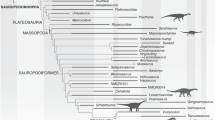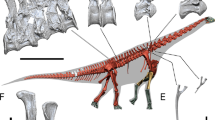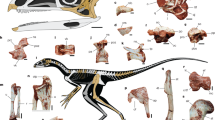Abstract
Dinosaurs dominated the terrestrial ecosystems for more than 140 Myr during the Mesozoic era, and among them were sauropodomorphs, the largest land animals recorded in the history of life. Early sauropodomorphs were small bipeds, and it was long believed that acquisition of giant body size in this clade (over 10 tonnes) occurred during the Jurassic and was linked to numerous skeletal modifications present in Eusauropoda. Although the origin of gigantism in sauropodomorphs was a pivotal stage in the history of dinosaurs, an incomplete fossil record obscures details of this crucial evolutionary change. Here, we describe a new sauropodomorph from the Late Triassic of Argentina nested within a clade of other non-eusauropods from southwest Pangaea. Members of this clade attained large body size while maintaining a plesiomorphic cyclical growth pattern, displaying many features of the body plan of basal sauropodomorphs and lacking most anatomical traits previously regarded as adaptations to gigantism. This novel strategy highlights a highly accelerated growth rate, an improved avian-style respiratory system, and modifications of the vertebral epaxial musculature and hindlimbs as critical to the evolution of gigantism. This reveals that the first pulse towards gigantism in dinosaurs occurred over 30 Myr before the appearance of the first eusauropods.
This is a preview of subscription content, access via your institution
Access options
Access Nature and 54 other Nature Portfolio journals
Get Nature+, our best-value online-access subscription
$29.99 / 30 days
cancel any time
Subscribe to this journal
Receive 12 digital issues and online access to articles
$119.00 per year
only $9.92 per issue
Buy this article
- Purchase on Springer Link
- Instant access to full article PDF
Prices may be subject to local taxes which are calculated during checkout



Similar content being viewed by others
References
Benton, M. J. in The Dinosauria (eds Weishampel, D. B., Dodson, P. & Osmolska, H.) 7–19 (Univ. California Press, Berkeley, 2004).
Brusatte, S. L., Benton, M. J., Ruta, M. & Lloyd, G. T. The first 50 Myr of dinosaur evolution: macroevolutionary pattern and morphological disparity. Biol. Lett. 4, 733–736 (2008).
Brusatte, S. L., Benton, M. J., Ruta, M. & Lloyd, G. Superiority, competition and opportunism in the evolutionary radiation of dinosaurs. Science 321, 1485–1488 (2008).
Brusatte, S. L. et al. The origin and early radiation of dinosaurs. Earth Sci. Rev. 101, 68–100 (2010).
Langer, M. C., Ezcurra, M. D., Bittencourt, J. & Novas, F. E. The origin and early evolution of dinosaurs. Biol. Rev. Camb. Phil. Soc. 85, 55–110 (2010).
Martínez, R. N. et al. A basal dinosaur from the dawn of the dinosaur era in southwestern Pangaea. Science 331, 201–210 (2011).
Nesbitt, S. J. The early evolution of archosaurs: relationships and the origin of major clades. Bull. Am. Mus. Nat. Hist. 352, 1–292 (2011).
Benton, M. J., Forth, J. & Langer, M. C. Models for the rise of the dinosaurs. Curr. Biol. 24, 87–95 (2014).
Galton, P. M. & Upchurch, P. in The Dinosauria (eds Weishampel, D. B., Dodson, P. & Osmolska, H.) 232–258 (Univ. California Press, Berkeley, 2004).
Upchurch, P., Barrett, P. M. & Dodson, P. in The Dinosauria (eds Weishampel, D. B., Dodson, P. & Osmólska, H.) 259–322 (Univ. California Press, Berkeley, 2004).
Mannion, P. D., Upchurch, P., Carrano, M. T. & Barrett, P. M. Testing the effect of the rock record on diversity: a multidisciplinary approach to elucidating the generic richness of sauropodomorph dinosaurs through time. Biol. Rev. 86, 157–181 (2011).
Klein, N., Remes, K., Gee, C. T. & Sander, P. M. Biology of the Sauropod Dinosaurs: Understanding the Life of Giants (Indiana Univ. Press, Bloomington, 2011).
Rauhut, O. W. M., Fechner, R., Remes, K. & Reis, K. in Biology of the Sauropod Dinosaurs: Understanding the Life of Giants (eds Klein, N., Remes, K., Gee, C. T. & Sander, P. M.) 119–149 (Indiana Univ. Press, Bloomington, 2011).
Sander, P. M. et al. Biology of the sauropod dinosaurs: the evolution of gigantism. Biol. Rev. 86, 117–155 (2011).
Sander, P. M. Sauropod Gigantism: A Cross-Disciplinary Approach (PLoS ONE Collection, Berkely, 2013).
Benson, R. B. J. et al. Rates of dinosaur body mass evolution indicate 170 million years of sustained ecological innovation on the avian stem lineage. PLoS Biol. 12, e1001853 (2014).
Benson, R. B. J., Hunt, G., Carrano, M. T. & Campione, N. E. Cope’s rule and the adaptive landscape of dinosaur body size evolution. Palaeontology 61, 13–48 (2018).
Wilson, J. A. & Sereno, P. C. Early evolution and higher-level phylogeny of sauropod dinosaurs. Soc. Vert. Paleontol. Mem. 5, 1–68 (1998).
Sander, P. M. et al. Adaptative radiation in sauropod dinosaurs: bone histology indicates rapid evolution of giant body size through acceleration. Org. Div. Evol. 4, 165–173 (2004).
Sander, P. M. An evolutionary cascade model for sauropod dinosaur gigantism—overview, update and tests. PLoS ONE 8, e78573 (2013).
Lacovara, K. J. et al. A gigantic, exceptionally complete titanosaurian sauropod dinosaur from southern Patagonia, Argentina. Sci. Rep. 4, 6196 (2014).
Carballido, J. L. et al. A new giant titanosaur sheds light on body mass evolution among sauropod dinosaurs. Proc. R. Soc. B 284, 20171219 (2017).
Martínez, R. N. et al. A new Late Triassic vertebrate assemblage from northwestern Argentina. Ameghiniana 52, 379–390 (2015).
Bonaparte, J. F. Evolución de las vertebras presacras en Sauropodomorpha. Ameghiniana 36, 115–187 (1999).
McPhee, B. W., Bonnan, M. F., Yates, A. M., Neveling, J. & Choiniere, J. N. A new basal sauropod from the pre-Toarcian Jurassic of South Africa: evidence of niche-partitioning at the sauropodomorph–sauropod boundary? Sci. Rep. 5, 13224 (2015).
Wilson, J. A., D’Emic, M. D., Ikejiri, T., Moacdieh, E. M. & Whitlock, J. A. A nomenclature for vertebral fossae in sauropods and other saurischian dinosaurs. PLoS ONE 6, e17114 (2011).
Yates, A. M., Wedel, M. J. & Bonnan, M. F. The early evolution of postcranial skeletal pneumaticity in sauropodomorph dinosaurs. Acta Palaeontol. Pol. 57, 85–100 (2012).
Kent, D. V., Santi Malnis, P., Colombi, C. E., Alcober, O. A. & Martínez, R. N. Age constraints on the dispersal of dinosaurs in the Late Triassic from magnetochronology of the Los Colorados Formation (Argentina). Proc. Natl Acad. Sci. USA 111, 7958–7963 (2014).
Pol, D. & Powell, J. E. New information on Lessemsaurus sauropoides (Dinosauria: Sauropodomorpha) from the Upper Triassic of Argentina. Spec. Pap. Palaeontol. 77, 223–243 (2007).
Yates, A. M. & Kitching, J. W. The earliest known sauropod dinosaur and the first steps towards sauropod locomotion. Proc. R. Soc. Lond. B 270, 1753–1758 (2003).
McPhee, B. W., Yates, A. M., Choiniere, J. N. & Abdala, F. The complete anatomy and phylogenetic relationships of Antetonitrus ingenipes (Sauropodiformes, Dinosauria): implications for the origins of Sauropoda. Zool. J. Lin. Soc. 171, 151–205 (2014).
Sander, P. M. & Tückmantel, C. Bone lamina thickness, bone apposition rates, and age estimates in sauropod humeri and femora. Paläontol. Z. 77, 161–172 (2003).
Cooper, M. R. A reassessment of Vulcanodon karibaensis Raath (Dinosauria: Saurischia) and the origin of the Sauropoda. Palaeont. Afr. 25, 203–231 (1984).
Allain, R. & Aquesbi, N. Anatomy and phylogenetic relationships of Tazoudasaurus naimi (Dinosauria, Sauropodomorpha) from the late Early Jurassic of Morocco. Geodiversitas 30, 345–424 (2008).
Yates, A. M., Bonnan, M. F., Neveling, J., Chinsamy, A. & Blackbeard, M. G. A new transitional sauropodomorph dinosaur from the Early Jurassic of South Africa and the evolution of sauropod feeding and quadrupedalism. Proc. R. Soc. B 277, 787–794 (2010).
Cerda, I. A. et al. Novel insight into the origin of the growth dynamics of sauropod dinosaurs. PLoS ONE 12, e0179707 (2017).
Salgado, L., Coria, R. A. & Calvo, J. O. Evolution of titanosaurid sauropods. I. Phylogenetic analysis based on the postcranial evidence. Ameghiniana 34, 3–32 (1997).
Viglietti, P. A. et al. Stratigraphy of the Vulcanodon type locality and its implications for regional correlations within the Karoo Supergroup. J. Afr. Earth Sci. 137, 149–156 (2017).
Krupandan, E., Otero, A. & Chinsamy, A. Preliminary phylogenetic and histological analysis of a Late Triassic sauropodomorph from the Lower Elliot Formation of Lesotho. J. Vert. Pal. 33, 158 (2013).
Sverdlova, N. S., Lambertz, M., Witzel, U. & Perry, S. F. Boundary conditions for heat transfer and evaporative cooling in the trachea and air sacs system of the domestic fowl: a two-dimensional CFD analysis. PLoS ONE 7, e45315 (2012).
Henderson, D. Sauropod necks: are they really for heat loss? PLoS ONE 8, e77108 (2013).
O’Connor, P. & Claessens, L. P. A. M. Basic avian pulmonary design and flow-through ventilation in non-avian theropod dinosaurs. Nature 436, 253–256 (2005).
Bonnan, M. F. & Yates, A. M. A new description of the forelimb of the basal sauropodomorph Melanorosaurus: implications for the evolution of pronation, manus shape and quadrupedalism in sauropod dinosaurs. Spec. Pap. Palaeontol. 77, 157–168 (2007).
Remes, K. Evolution of the Pectoral Girdle and Forelimb in Sauropodomorpha (Dinosauria, Saurischia): Osteology, Myology and Function. PhD thesis, Ludwig-Maximilians-Universität München (2008).
Fechner, R. Morphological Evolution of the Pelvic Girdle and Hindlimb of Dinosauromorpha on the Lineage to Sauropoda. PhD thesis, Ludwig-Maximilians-Universität München (2009).
Wilson, J. A. & Carrano, M. Titanosaurs and the origin of ‘wide-gauge’ trackways: a biomechanical and systematic perspective on sauropod locomotion. Paleobiology 25, 252–267 (1999).
McPhee, B. W., Bordy, E. M., Sciscio, L. & Choiniere, J. N. The sauropodomorph biostratigraphy of the Elliot Formation of southern Africa: tracking the evolution of Sauropodomorpha across the Triassic–Jurassic boundary. Acta Palaeontol. Pol. 62, 441–465 (2017).
Chinsamy, A. & Raath, M. A. Preparation of fossil bone for histological examination. Palaeontol. Afr. 29, 39–44 (1992).
Francillon-Vieillot, H. et al. in Skeletal Biomineralization: Patterns, Processes and Evolutionary Trends Vol. 1 (ed. Carter, J. G.) 471–530 (Van Nostrand Reinhold, New York, 1990).
De Ricqlès, A., Meunier, F. J., Castanet, J. & Francillon-Vieillot, E. in Bone Vol. 3 (ed. Hall, B. K.) 1–78 (CRC Press, Boca Raton, 1991).
Goloboff, P. A., Farris, J. S. & Nixon, K. C. TNT: a free program for phylogenetic analysis. Cladistics 24, 774–786 (2008).
Wilkinson, M. Common cladistic information and its consensus representation: reduced Adams and reduced cladistic consensus trees and profiles. Syst. Biol. 43, 343–368 (1994).
Pol, D. & Escapa, I. H. Unstable taxa in cladistics analysis: identification and the assessment of relevant characters. Cladistic 25, 512–527 (2009).
Sereno, P. C. Basal Sauropodomorpha: historical and recent phylogenetic hypotheses, with comments on Ammosaurus major (Marsh, 1989). Spec. Pap. Palaeontol. 77, 261–289 (2007).
Yates, A. M. Solving a dinosaurian puzzle: the identity of Aliwalia rex Galton. Hist. Biol. 19, 93–123 (2007).
Acknowledgements
We thank the Earthwatch Foundation and its volunteers for help during fieldtrips. Support was provided by the Argentinian National Science Agency FONCyT (to C.A. (Pict 2016-236), R.N.M. (Pict 2015-711), I.A.C. (Pict 2015-1021) and D.P. (Pict 2014-1288)), SECITI Gobierno de San Juan (to R.N.M. (2016-2017)) and a PalAss Small Grant (to C.A.). We thank J. Carballido, A. Otero, J. Wilson, S. Nesbitt, T. Rowe and F. Di Fresco for discussions and comments, and D. Abelin for preparation and photographs of the type materials.
Author information
Authors and Affiliations
Contributions
R.N.M. and O.A. designed the research project and conducted the fieldwork. C.A., R.N.M. and D.P. designed the manuscript and described the materials. I.A.C. conducted the histological analyses. C.A. and D.P. conducted the phylogenetic analyses. All authors wrote the manuscript.
Corresponding author
Ethics declarations
Competing interests
The authors declare no competing interests.
Additional information
Publisher’s note: Springer Nature remains neutral with regard to jurisdictional claims in published maps and institutional affiliations.
Supplementary information
Supplementary Information
Supplementary Information and References
Supplementary Dataset
Phylogenetic matrix of sauropodomorpha
Supplementary Table 1
Measurements of the bone elements of Ingentia prima (PVSJ 1086-1087) and new referred specimens of Lessemsaurus sauropoides (CRIALAR PV-302-303, PVL 6580). The numbers of caudal vertebrae and pes phalanges indicate an estimated order but not a specific number of each element. The height of the vertebral centra refers to the posterior face of each centrum. Abbreviations: Ca, caudal vertebra; Cv, cervical vertebra; dc, distal carpal; dt, distal tarsal; H, height; L, length; Lt, lateral; M, medial; mc, metacarpal; mt, metatarsal; ph, phalanx; PR, proximal ulna ratio (lateral margin versus medial margin=radial fossa margin); prox., proximal; TL, transversal length; w/s, without spine (=from neurocentral suture to postzygapophyses level). All measurements are provided in mm and indicate the maximum linear length. Estimated measurements are denoted by asterisk, and absent elements are denoted by double hyphen
Supplementary Table 2
Measurements of equivalent bone elements (scapula and ilium) and Body masses estimated for Sauropodomorpha. The measurements of bones are provided in mm and indicate the maximum linear length of each element. The body mass is provided in Kg. Incomplete elements or absent dates are denoted by double hyphen. Abbreviations: Abb., abbreviation used in the figure; BM, body mass; Il, ilium; L, total length; NA, not applicable; Sc, scapula. Simple asterisk indicates the specimen used by Benson et al. 2018 for estimation of BM, double asterisk indicate the new Lessemsaurus specimen reported here; apostrophe indicates length estimated from the literature
Rights and permissions
About this article
Cite this article
Apaldetti, C., Martínez, R.N., Cerda, I.A. et al. An early trend towards gigantism in Triassic sauropodomorph dinosaurs. Nat Ecol Evol 2, 1227–1232 (2018). https://doi.org/10.1038/s41559-018-0599-y
Received:
Accepted:
Published:
Issue Date:
DOI: https://doi.org/10.1038/s41559-018-0599-y
This article is cited by
-
Africa’s oldest dinosaurs reveal early suppression of dinosaur distribution
Nature (2022)
-
Earliest evidence of herd-living and age segregation amongst dinosaurs
Scientific Reports (2021)
-
Sauropodomorph evolution across the Triassic–Jurassic boundary: body size, locomotion, and their influence on morphological disparity
Scientific Reports (2021)
-
A derived sauropodiform dinosaur and other sauropodomorph material from the Late Triassic of Canton Schaffhausen, Switzerland
Swiss Journal of Geosciences (2020)



